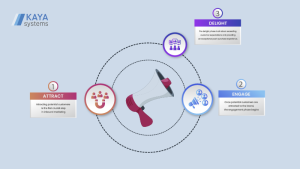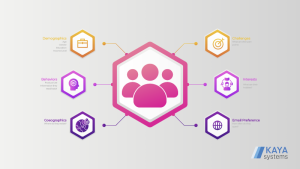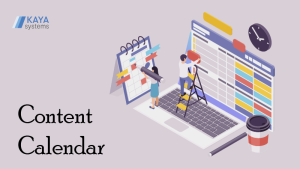
Introduction
In today’s fast-paced and ever-evolving digital landscape, creating a powerful inbound marketing strategy is essential for businesses to connect with their target audience, drive meaningful engagement, and ultimately achieve sustainable growth. Inbound marketing, a customer-centric approach that focuses on attracting prospects through valuable content and personalized experiences, continues to be a driving force in the marketing world in 2023. In this comprehensive guide, we will delve into the key components of a potent inbound marketing strategy that will empower businesses to stand out, thrive, and build lasting relationships with their customers.
Why is Inbound Marketing Needed?

Inbound marketing is essential because it aligns with the changing consumer behavior and preferences in the digital age. Unlike traditional outbound marketing, which interrupts potential customers with unsolicited messages, inbound marketing focuses on attracting, engaging, and delighting prospects through valuable and relevant content. With the rise of ad-blocking software and consumers becoming adept at ignoring traditional advertising, businesses need a more customer-centric approach to capture their attention. It provides businesses with the means to build trust, establish authority, and cultivate long-term relationships with their target audience.
By delivering content that addresses specific pain points and caters to the needs of potential customers, it not only generates leads but also nurtures them through their buyer’s journey, resulting in higher conversion rates, customer satisfaction, and brand loyalty.
Types of Inbound Marketing
Here are three ways an inbound marketing strategy can be successfully applied:
1- Attract
2- Engage
3- Delight

Attract:
Attracting potential customers is the first crucial step in inbound marketing. This stage involves creating and distributing valuable and relevant content to draw in the right audience to your brand. Content can take various forms, including blog posts, social media posts, videos, infographics, and more. By optimizing content for search engines and utilizing social media platforms, businesses can increase their online visibility and reach. The goal is to provide content that aligns with the interests and needs of the target audience, positioning the brand as an authoritative and trustworthy source in the industry. Through this attraction phase, businesses can generate qualified leads and initiate the relationship-building process.
Engage:
Once potential customers are attracted to the brand, the engagement phase begins. At this stage, businesses focus on building deeper connections with their audience and nurturing leads through personalized interactions. Effective engagement can be achieved through email marketing, social media interactions, live chat support, webinars, and other interactive forms of communication. By understanding the specific pain points and preferences of individual leads, businesses can deliver tailored content and solutions. The goal is to keep prospects engaged and interested in the brand, guiding them further along their buyer’s journey. Engaging with prospects in a meaningful way enhances their experience with the brand, increasing the likelihood of conversion and brand loyalty.
Delight:
The delight phase is all about exceeding customer expectations and providing an exceptional post-purchase experience. Delighted customers are more likely to become brand advocates, promoting the business through word-of-mouth and social media. To achieve delight, businesses can offer outstanding customer support, exclusive loyalty programs, personalized follow-ups, and continuously valuable content. Satisfied customers who feel valued and appreciated are more inclined to make repeat purchases and become loyal, long-term customers. Additionally, delighted customers are more likely to leave positive reviews and testimonials, further bolstering the brand’s reputation and attracting new prospects through word-of-mouth referrals.
Plan Your Inbound Marketing Strategy
Before diving into crafting the perfect inbound marketing strategy and its numerous advantages, it’s crucial to notify your content team in advance, as they will have a significant workload ahead.
- Define Your Goals:
Before diving into your inbound marketing efforts, it’s essential to clearly define your objectives. Determine what you want to achieve through your marketing strategy—whether it’s increasing brand awareness, generating more leads, boosting sales, or enhancing customer engagement. Having well-defined goals will provide direction and focus to your marketing activities.
- Analyze Your Competitors:
Understanding your competition is crucial in developing an effective marketing strategy. Conduct a thorough analysis of your competitors to identify their strengths, weaknesses, and unique selling points. This analysis will help you gain insights into the market landscape and discover opportunities to differentiate your brand and stand out from the crowd.
- Identify Buyer Personas:

Buyer personas represent your ideal customers. Create detailed profiles of your target audience, including their demographics, preferences, pain points, and buying behavior. Understanding your audience will enable you to tailor your content and marketing messages to resonate with their needs and interests, ultimately increasing the effectiveness of your campaigns.
- Follow the Trends:
Stay updated with the latest industry trends and advancements in technology and marketing techniques. In the fast-paced digital landscape, trends can change rapidly, and it’s essential to adapt your strategies accordingly. This may involve incorporating new social media platforms, adopting emerging technologies, or adjusting your content format to align with current preferences.
- Create a Content Calendar:

Consistency is key to successful inbound marketing. Develop a content calendar to plan and organize your content creation and distribution schedule. This calendar should include topics, keywords, publishing dates, and the platforms where you’ll share your content. A well-structured content calendar ensures that you consistently deliver valuable content to your audience, keeping them engaged and informed.
- Choose Delivery Platforms:
Select the most appropriate channels and platforms to reach your target audience effectively. This decision will depend on your buyer personas and where they are most active online. Consider utilizing social media platforms, email marketing, blogs, podcasts, webinars, or other content distribution channels that align with your audience’s preferences.
- Analyze and Optimize:
Regularly measure and analyze the performance of your inbound marketing efforts. Utilize key performance indicators (KPIs) relevant to your goals, such as website traffic, conversion rates, engagement metrics, and ROI. Based on these insights, make data-driven decisions to optimize your marketing strategies continually. This process of analysis and optimization allows you to refine your approach and maximize the impact of your inbound marketing efforts.
By following these steps and continuously learning from your results, you can build a robust inbound marketing strategy that effectively connects with your target audience and drives desired outcomes for your business.
Start Your Inbound Marketing Strategy
Having a well-developed strategy is crucial for attaining flawless execution of your plans and achieving satisfactory results. If you’re embarking on the path of crafting a seamless inbound marketing strategy, these approaches will assist you in effortlessly marketing to your target audience.
- Write Persuasive Content:
Content lies at the core of inbound marketing, and it should be persuasive, valuable, and relevant to your target audience. Utilize various content formats to engage and attract prospects throughout their buyer’s journey. Blogs provide an excellent platform for informative articles that showcase your expertise and address customer pain points. Videos are highly engaging and can be used for product demonstrations, tutorials, or storytelling. Testimonials and case studies serve as social proof, building trust with potential customers. How-to guides offer step-by-step solutions to common problems, positioning your brand as a helpful resource. Infographics present complex information in a visually appealing and easy-to-digest format, making them shareable and informative.
- Survey Your Existing Customers:
Gaining insights from your existing customers is invaluable for refining your inbound marketing strategy. Conduct surveys to understand their preferences, pain points, and overall satisfaction with your products or services. Feedback from customers allows you to identify areas of improvement, tailor content to their needs, and nurture loyalty. Utilize their testimonials to showcase positive experiences and build credibility with prospects. Listening to your customers’ feedback demonstrates that you care about their opinions and are committed to providing the best possible experience.
- Rely on Guest Posting:
Guest posting is an effective way to expand your brand’s reach and build authority in your industry. Contribute guest posts to reputable websites and blogs that share a similar target audience. This not only increases your brand’s visibility but also establishes you as an expert in your field. Ensure your guest posts offer valuable insights and solutions, rather than being purely promotional. A well-crafted guest post can drive traffic back to your website and attract new potential customers.
- Build Strong Email Campaigns:
Email marketing remains a powerful tool for nurturing leads and maintaining customer relationships. Create targeted and personalized email campaigns that cater to specific segments of your audience. Segment your email list based on customer behavior, interests, and buying patterns to deliver relevant content. Automate your email campaigns to ensure timely and consistent communication. Offer valuable content, promotions, and exclusive offers to keep your audience engaged and interested in your brand.
- Optimize for SEO:
Search Engine Optimization (SEO) is crucial for increasing your website’s visibility in search engine results, attracting organic traffic, and driving potential customers to your site.

– On-page SEO involves optimizing individual web pages with relevant keywords, meta tags, and quality content. Use keyword research to identify the phrases your target audience is searching for and naturally incorporate them into your content and meta tags.
– Off-page SEO involves building high-quality backlinks from reputable websites, which signals to search engines that your content is valuable and authoritative. Focus on guest posting, influencer outreach, and social media marketing to acquire backlinks.
– Technical SEO ensures that your website is optimized for search engine crawlers. Improve site speed, fix broken links, and implement structured data markup to enhance your website’s performance in search results.
- Use the Right Tools:
There are numerous tools available to help streamline and enhance your inbound marketing efforts. Utilize marketing automation platforms to automate email campaigns, segment audiences, and track customer interactions. Content management systems (CMS) enable easy content creation and publishing. Keyword research tools aid in identifying relevant search terms. Social media management tools help schedule posts and monitor engagement. Choose the tools that align with your specific needs and budget to streamline your inbound marketing operations effectively.
- Make Your Website Mobile-Friendly:
With a significant portion of internet users accessing content on mobile devices, having a mobile-friendly website is essential for a successful inbound marketing strategy. Optimize your website’s design and user experience for mobile users to ensure easy navigation, quick load times, and readability on smaller screens. A responsive website adapts to various devices, providing a seamless experience for users regardless of their chosen platform. A mobile-friendly website boosts your SEO rankings and enhances the overall user experience, increasing the likelihood of customer engagement and conversions.
Tags: SEO Copywriting Agency


 Jul 25 2023
Jul 25 2023  Posted by: admin
Posted by: admin  Posted in
Posted in